Cloudpunk is the story of Rania, a musician from the East Peninsula. When her home is seized by a DebtCorp, Rania is forced to put down her flute and relocate to Visalis, the last city on Earth, where she gets a job as a driver for a delivery company called Cloudpunk. It’s not a good job; most drivers don’t last their first night, and though the company is legal, it is sometimes contracted to deliver illicit goods. Drivers are often reminded of Cloudpunk’s two guidelines: Don’t be late, and never open the package. Over the course of this twelve hour narratively-driven adventure, I guide Rania through her first night on the job, a night that proves fateful both for the protagonist and the city as deliveries are accompanied by whispers of a mysterious entity named CORA.
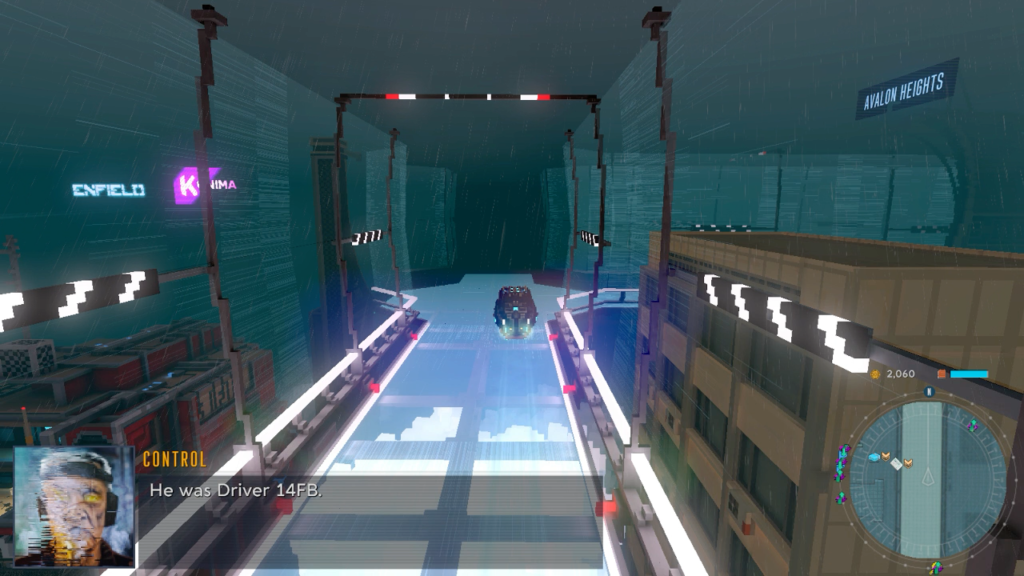
Most of my time in Cloudpunk is spent driving around Visalis in a flying car called a HOVA. It’s a bare-bones vehicle, able to accelerate, brake, drive in reverse, turn left and right, and ascend and descend, but there are no handbraking shenanigans here. I cannot do loops through Visalis’ cloudy alleyways or dodge oncoming traffic with a well-timed barrel roll. That’s not the kind of videogame that Cloudpunk is. There are a few timed missions, but they are easy to finish within the limit. The HOVA is a vehicle to deliver myself and the player character between plot points, not a thrill-seeking hot rod, just as Cloudpunk is a self-paced narrative adventure and not an atmosphere-burning racer.
But it’s not enough that I drive between destinations. A waypoint guides me through Visalis’ various boroughs to a floating city “block” where I will make Rania’s next pickup or delivery, but I must first find a parking spot for the HOVA so she can proceed on foot. From there I walk in first- or third-person perspectives along catwalks connecting Visalis’ floating island-blocks. These sequences are where Cloudpunk asks the most of my ability to navigate, as I must sometimes use elevators and doorways to ascend and descend levels to reach the waypoint. These structures aren’t exactly mazes, but navigating them is the most taxing game design I encountered in my entire experience.
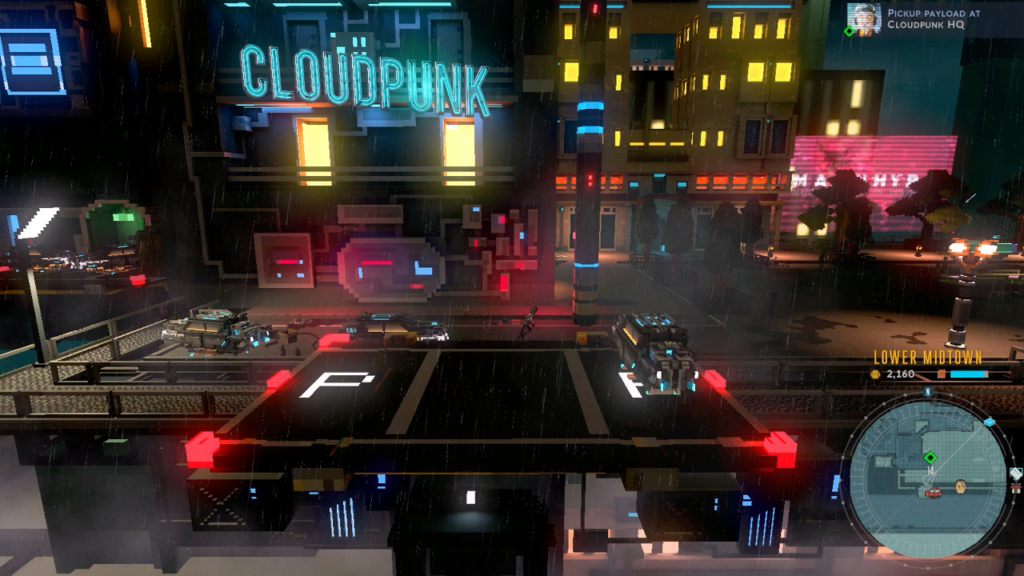
Strewn across these structures are dozens of pickups. Some of these are keys that open locks, such as Coolant that repairs broken elevators and CorpSec Flyers that open security barriers, while others exist only to be sold for profit. In addition to payments for completing deliveries, I can use Rania’s earnings to upgrade the HOVA’s speed and handling and purchase decorations for her apartment. Money is also used to refuel the HOVA and repair it from damage, but not once in my playtime did I feel it was in danger of being destroyed or running out of gas. Cloudpunk isn’t that kind of videogame; having to manage a fuel resource and spend time respawning from a fatal car crash would distract from continuing the story. Their inclusion is a mundane detail that adds veracity to the setting.
While I walk and drive between the waypoints marking Rania’s delivery jobs, Cloudpunk’s story plays out through fully-voiced dialogue that runs at the screen’s bottom, and the voice talent does a good job of making the setting feel real. I appreciate that the plot isn’t kicked off by the obvious choice of Rania opening a package she’s not supposed to; the story feels quite slice-of-life at times. One early story beat has Rania take a coffee break where she playfully fends off a date request from an overly-interested Nice Guy. She can have many more encounters with parodies of the worst sorts of men, and Rania satisfyingly always comes out on top in their verbal exchanges. But soon her competence as a Cloudpunk delivery driver catches up with her when an illicit delivery crosses her path with a figure responsible for Visalis’ decaying state.
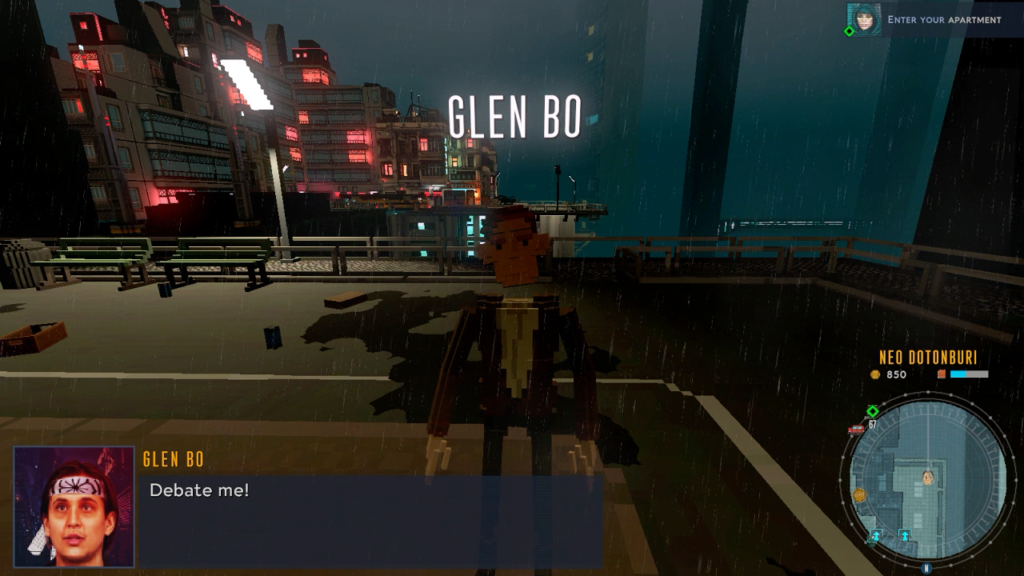
The biggest problem with Cloudpunk’s story is it lacks cohesiveness. Many plot threads chase Rania through her first night on the job, and though they all conclude, they don’t all feel related. In particular, a subplot involving a CorpSec agent named Reoh dominates a large portion of the plot’s middle section and permanently changes Rania’s future in Visalis, but has no actual connection to the plot’s climax. Cloudpunk feels like a hodgepodge of stories and ideas combined into one, ideas that would work episodically when focusing on multiple characters, but here in a single story focused on a single character they feel chaotic and confused.
The story may not feel cohesive, but it does capture a fully realized world. Visalis is a rain-drenched labyrinth of buildings cloaked in perpetual nighttime, tattooed by blazing neon and smothering corporate advertising; if you’ve seen Blade Runner’s vision of a future Los Angeles, then you’ve seen Visalis.
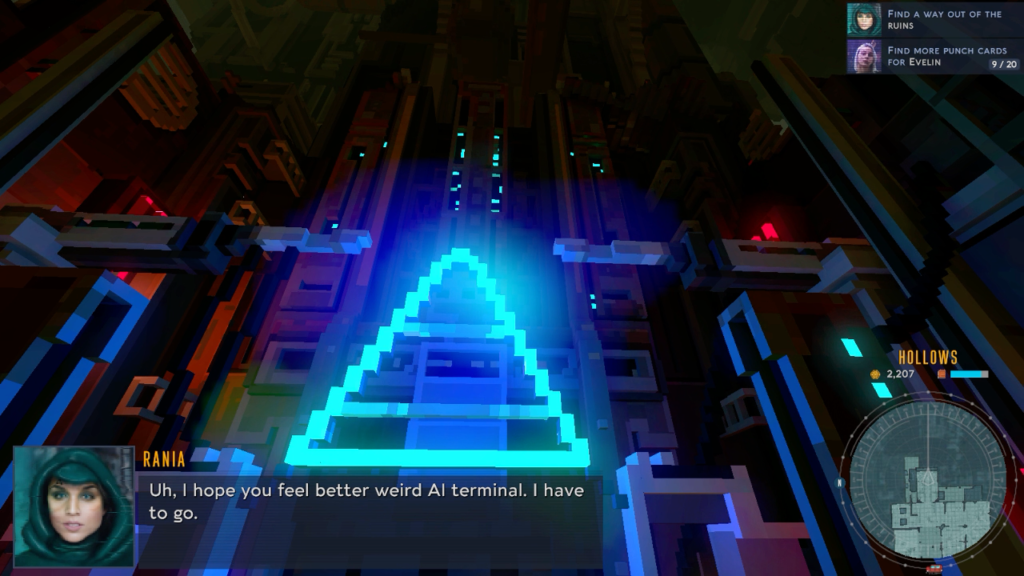
By interpreting subtext in the main plot, speaking to random citizens, and overhearing pieces of news and gossip as I guide Rania through the city blocks, I earn a deeper understanding of how the city works. Androids have only recently been recognized as autonomous individuals and are still thought of as sub-human by many people; many people have altered themselves with cybernetic implants, some malfunctioning through malice, neglect, or plain wear, while others work for their user a little too well; Visalis (and the rest of the world, it seems) is run by an unnamed corporation or corporations, the CEOs living above the clouds in “The Spire” and running the city below as a police state enforced by their goon-like CorpSec agents. This system has existed for so long that people have forgotten what the acronym “CEO” means. Cloudpunk employs standard cyberpunk themes and tropes, but they’re done well. I found it familiar and enjoyable.
Cloudpunk utilizes voxel-based graphics to represent its world. I often find voxels in videogames ugly, a lazy shortcut smuggled into the realm of acceptance by piggybacking on the success of Minecraft. But Cloudpunk makes the aesthetic work. Its voxels are much smaller and denser than in most other voxel-built videogames, creating an illusion of smooth beauty from a distance that becomes ugly and jagged when viewed up close—much like the world of Cloudpunk itself. The use of light is also impressive, almost everything existing in darkness but lit on one side by the neon lights that adorn the buildings above, a constant reminder of the corporate advertising that blemishes what should be a person’s home. It’s not the best looking videogame out there, but it is memorable and distinct.
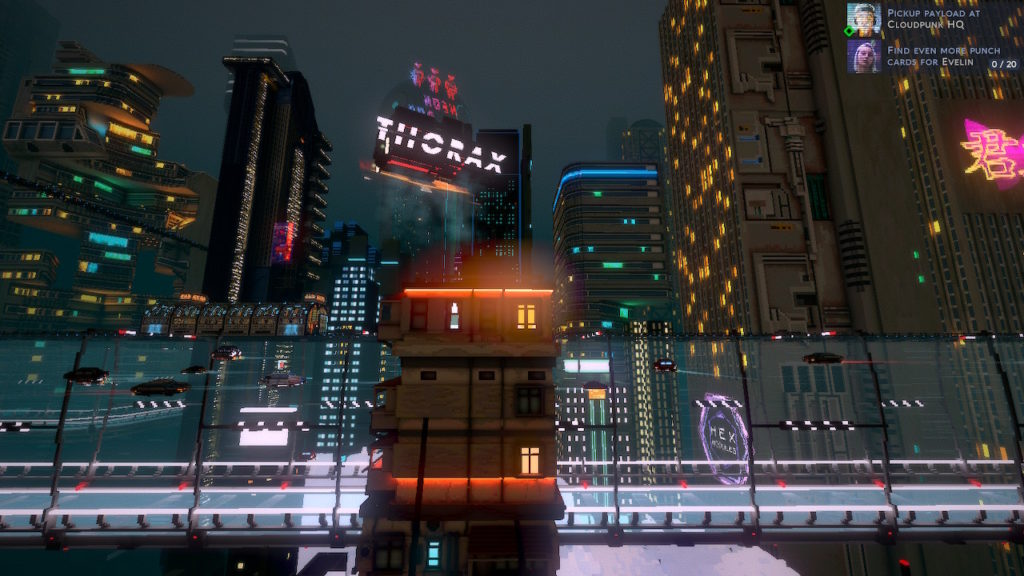
Cloudpunk never tries to be more than what it is. It’s a narratively-driven videogame that uses a flying car to move player and player character around a sandbox, but since obstacle courses and races will not advance Rania’s story, there are none to be found. It’s a cyberpunk setting that doesn’t explore anything new in the cyberpunk genre, but fulfills its requirements well. It’s like a lesser-known work in a science-fiction compilation, the kind that is listed in the table of contents but never on the cover, respectable but not notable. I wish all the plot threads that entangle Rania on her first night on the job had joined together into a beautiful fibrous rope, since this lack of cohesion is the main thing holding the narrative back. But I still enjoyed Cloudpunk, and I believe genre fans will enjoy it as well.